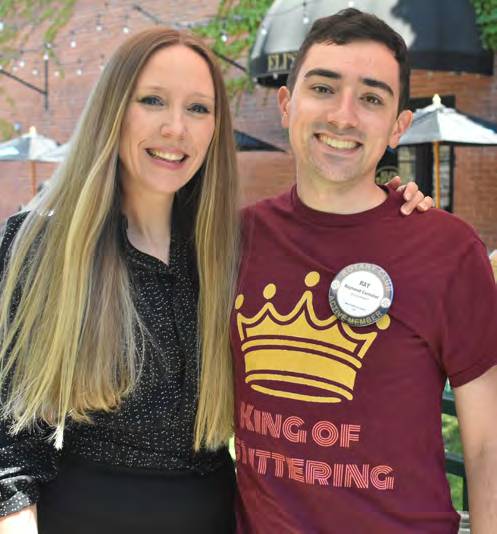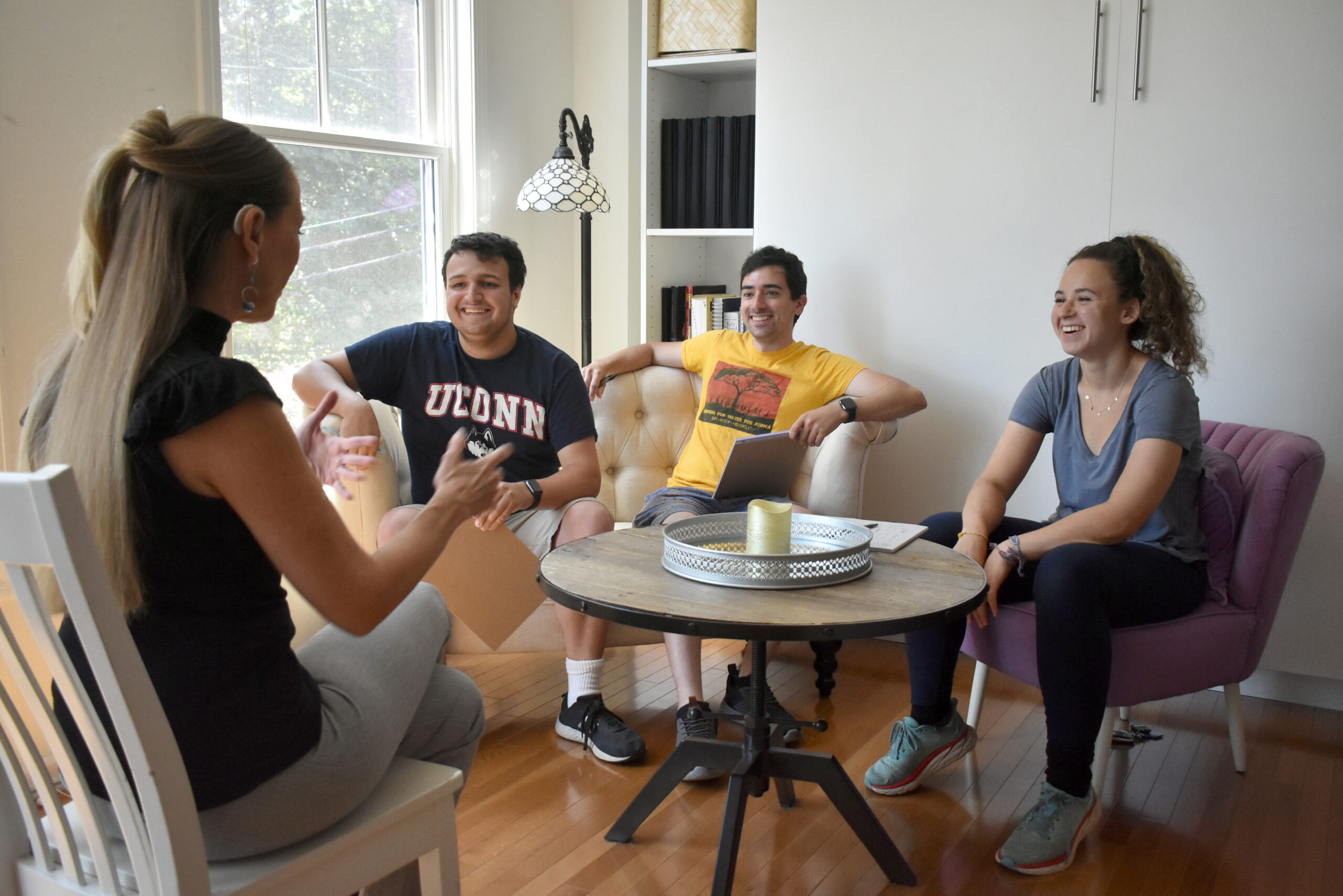Stuttering Speech Therapy Services
SET YOURSELF FREE.
Stuttering Therapy Services
Explore your online and in-person (Milford, CT) stuttering speech therapy options below!

INDIVIDUAL THERAPY
1:1 stuttering therapy online or in person. Explore Individual Therapy >

GROUP THERAPY
Group stuttering therapy online or in person. Explore Group Therapy >

Stuttering Therapy Retreats
Powerful five-day therapy retreat in Connecticut. Explore Upcoming Retreats >

Welcome to Hope For Stuttering
I am an experienced speech therapist that specializes exclusively in treating stuttering and cluttering for all ages with online and in person options.
I am a certified specialist in Stuttering Speech Therapy with the American Board of Stuttering, Cluttering, and Fluency Disorders and located in Milford CT. Since 2001 I’ve helped those who stutter transform and flourish.
CHAMONIX OLSEN – M.S., CCC-SLP, BCS-SCF
ASHA Board Certified • Licensed in: CT, CA, NY, FL, MA, NJ & SC
Join My VIP List
Why choose stuttering therapy with a board certified stuttering therapist?
Board certified stuttering speech therapists provide the highest standard of care for stuttering, cluttering, and fluency disorders. We undergo extensive training to become experts in stuttering therapy. After obtaining a master’s degree in speech-language pathology and then treating clients for 3 years, a candidate can apply for board certification. It often takes 3 years to then go through the board certification process.
Board certified stuttering therapists provide clients with the most up-to-date treatment methods and resources, as extensive ongoing training and education covering current research is required to maintain board certification. Certified stuttering specialists also must abide by rules and ethics established by licensing and certification boards, whom aim to protect those who stutter.
A professional with this level of training and certification is able to identify when a language disorder may be part of the picture, if a neurologist referral is needed, is adept at differential diagnosis, and has accountability to licensing boards.
A speech therapist that specializes in stuttering and only works with clients who stutter is very rare.
Sign up for a consultation to meet me and discover the best course of therapy for you.


Philosophy of Treatment
The key to the art of therapy is knowing what to use when for each individual client.
My relationship with my clients is my passion. I care about them deeply. Over the years, I have been trained in many different stuttering approaches, counseling, and I have advanced training and certifications in nervous system regulation tools; strategies to help calm the parts of the brain that can become over activated; and in resiliency building approaches. I’m a holistic practitioner that thinks outside of the box and have implemented trauma informed therapy for over a decade.
What do I do? I’m not someone who stutters myself, but I have my own story of struggle, transforming, and overcoming. I am someone with great empathy and a passion for helping. I believe the art of therapy is key. What to use and when for each individual client is the art, and this creates unique treatment for each person. I meet the client where they are and journey alongside them. I introduce things when there is opportunity and I plant seeds. I respect each client.
I believe that stuttering is okay. I believe that living a life driven by fear can be transformed to living in freedom. I desire to help each client flourish.
What is Stuttering?
Developmental stuttering is a way of talking characterized by the sensation of being stuck and a loss of control. There are often disruptions in the forward flow of speech, such as repetitions of words or parts of words, prolongations of sounds, or complete blockages of sounds. Those who stutter know what they want to say, more time is required to say it. There may also be physical tension or struggle.
Avoidance behaviors consist of a wide variety of things people who stutter do to try not to stutter. These are learned reactions to stuttering and become part of the overall pattern.
Anticipation and fear can grow and become a predominant component and fuel the physical expression of stuttering. These avoidance behaviors can interfere greatly with effective communication and quality of life.
If not identified and treated early, stuttering and more importantly, resistance to stuttering and negative experiences with stuttering, often impacts social, emotional, and educational development. Some also experience stuttering as traumatic. All of this can greatly limit one’s ability to fully participate in life or to achieve one’s social or occupational goals. The nervous system can become very dysregulated and the brain can get caught in loops of thinking and anticipating and re-living.
- Approximately 5% of children stutter, 20% of those will persist in stuttering.
- Approximately 1% of adults stutter equaling approximately 3-4 million in the United States.
- Stuttering most often begins between the ages of 2-3 ½ years.
- 4-5 times as many males than females stutter. When children are very young this number is closer to equal.


Cluttering vs Stuttering
What is the difference between cluttering and stuttering? Here’s a quick rundown of each.
Cluttering is characterized by a rapid or irregular rate, irregular rhythm, pauses in unusual places, unusual prosody, omitting sounds from multisyllabic words, and an excessive amount of normal disfluencies such as the use of “um” or “like” and whole word repetitions. These do not have struggle or tension in them.
When someone clutters, the message is not clear or concise and they are not well understood. Those who clutter are often asked to repeat what they said and are often unaware of their difficulty with communication. Their speech sounds as if words are running into each other. Sometimes there is difficulty organizing thoughts.
A client described his cluttering like this: “It’s when I speak rapidly and put all the syllables in the same word or it feels like I make all of my words on the same syllable. It doesn’t make a lot of sense sometimes. People have trouble knowing what I am saying. Everything slurs together. When I was younger I had no idea I was doing it and I grew accustomed to myself being a rapid talker. Later I realized I wasn’t just a rapid talker and people would have trouble knowing what I was saying. If I ever heard a recording of myself I would get chills because it wouldn’t sound like the same person I heard in my head. To me I was speaking totally fluent and clear and it all made sense.”
Stuttering on the other hand is characterized by an involuntary repetition or prolongation of sounds, syllables, or words and blocking on sounds. People who stutter know what they want to say but need more time to say it. They are aware of these involuntary moments of loss of control and often have struggle behavior to gain back control. Avoidance behaviors are very common, along with fear and anticipation, which differs from cluttering.
What causes Stuttering?
Current research supports the cause of stuttering to be neurophysiological and many have a genetic predisposition. Brain imaging studies show differences in brain activity and structure for those who stutter compared to those who do not. Multiple factors often come together for young children who begin to stutter, with environmental stressors and temperament being important. Language factors, being male, and having a family history are linked to persistent stuttering.
There is not a psychological cause for stuttering, although many children, teens, and adults develop psychological and learned responses as they experience and anticipate stuttering. Trauma responses can also develop. These beliefs, thoughts, fears, avoidances, and learned patterns can grow and add to the complexity. These components can become the most predominant parts and are vital to address in treatment. Stress can increase the amount and tension of stuttering, but it is not the root cause.
Stuttering does not discriminate according to race, country of origin, intelligence, or language spoken.
If you are being impacted in negative ways by your stuttering, reach out for help. There is always hope!

WHAT CLIENTS SAY:
Stuttering is a part of you, but it doesn't have to define you.
ADULT CLIENT
Frequently Asked Questions
The closest we have to a cure is working with very young children who stutter shortly after they begin to stutter. Even then no one can guarantee even with the best treatment done early, that a child will stop stuttering. This is why it’s vital to prepare for continued stuttering and set the foundation of acceptance and openness in order to prevent the negative impact of resisting stuttering. Stuttering has neurophysiological roots. There is no magical strategy, pill, or treatment that will make it stop forever. Don’t be discouraged though, there is great hope! There are many treatment choices you have as someone who stutters and life can drastically change for the better!
No. If it were that easy everyone would have stopped stuttering long ago. For some, slowing down can be helpful but being told to slow down doesn’t help because how will you slow down? Just thinking “slow down” only lasts for a few seconds. There are numerous ways to reduce rate, and if someone who stutters wants to focus on that, it’s their choice. Most people who stutter prefer not to receive any feedback about their speech. As a listener, accept the stuttering you are hearing. We all notice and adjust to the different ways people speak. Keep normal eye contact when speaking with someone who stutters, listen to what they are saying versus how they are saying it, don’t interrupt, and give them as much time as they need to speak. Basically be a good listener and do what you would want someone to do for you.
No two people who stutter are the same. Different things help different people. What helps one person may be very unhelpful or even backfire and be damaging to another person. The intention behind what you are doing is paramount. Are you using this strategy or approach out of fear and to suppress and resist your stuttering? If so, you probably will go in circles. Some clients may not be ready for or interested at all in a certain approach, so I meet them where they are. I’m not dogmatic. In my opinion, there is no one best way to treat all clients who stutter. This is why I believe in the art of therapy. It’s why I offer various options for treatment which focus on different things.
We meet and get to know each other! I learn about who you are, what you love in life, what your goals are, how your speech impacts you and what you’d like to be different. I review the forms you’ll fill out before the consultation and we may discuss them. I teach you about the causes and development of stuttering and make sure we are on the same page on the educational pieces. You teach me about your journey with stuttering and we’ll find out together if we are a good match and if you are a candidate for therapy with me! I’m assessing readiness for change and we decide together with my input and yours, what form of therapy may be most useful for you to get started.
The brain is used in a different way during these situations, therefore they are fluency inducing. Back and forth communication with a listener is different, involving time pressure and language being created in a unique way. Speaking is the most complex thing that we do! Over 100 muscles are involved and perfect coordination is required. The timing has to be exact and precise for fluency. Although we don’t have all the scientific answers to understand stuttering fully, we know that the brain is complex and our emotions are complex and there is an intermingling of many aspects.
This movement supports a belief that variations in neurological development and functioning across humans are a natural and valuable part of human variation and therefore not necessarily pathological (e.g., Jaarsma and Welin, 2012; Kapp, 2020). The Autism community was one of the first to embrace this way of thinking. Instead of placing stuttering under the terminology of “pathological” and “disordered” and being addressed within the medical model, proponents believe stuttering is a different way of talking and should be addressed within the social model. This model believes society needs to change their expectations for fluent speech and remove societal stigma around stuttering so that all ways of speaking are normalized, accepted, and valued.
